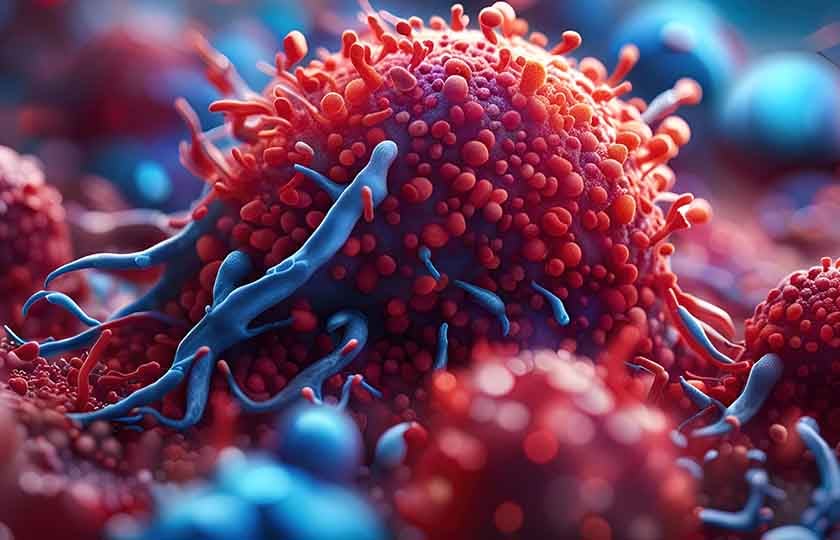Why cell migration and invasion is a rich seam for drug discovery
The capacity for cells to move, invade tissues, and migrate through the body is crucial for processes as diverse as embryonic development, tissue repair and cancer metastasis. As research continues to shed new light on the molecular mechanisms powering cell migration and invasion, it is opening up promising avenues for development of more effective and targeted therapies. Here we highlight 5 key areas of drug discovery where targeting cell migration and invasion mechanisms shows significant potential for advancing therapeutic interventions.
1. Tackling cancer metastasis and tumor angiogenesis at their biological roots
Metastasis, the spread of cancer cells from the primary tumor to distant organs, is a major cause of cancer-related deaths, and molecular mechanisms of cell invasion correlate strongly with progression of the metastatic cascade.[1,2] To metastasize, malignant cells must first invade the protective basement membrane of the tumor, migrate through the extracellular matrix (ECM) into surrounding tissue, pass through endothelial cell walls to enter and exit the circulatory system (intra- and extravasation), and colonize target tissues. Understanding the molecular drivers of this multi-stage cascade is key to stopping metastasis in its tracks.
Until recently, most cancer funding and development efforts have focused on antiproliferative agents and the clinical endpoint of tumor shrinkage, rather than on inhibition of local invasion and metastasis. To address this gap, researchers have defined a distinct new class of anti-cancer drugs called migrastatics, encompassing agents that interfere with all modes of cancer cell invasion and metastasis.[3] In addition to encouraging new avenues for drug discovery and shifting paradigms for clinical development, this increased focus on migrastatics has contributed to a wave of investigations into the repurposing of existing drugs and the development of new therapeutic combinations for treating metastatic disease.[3]
Targeting angiogenesis, the formation of new blood vessels, is another important focus area for cancer therapy, since tumors require a blood supply for growth and metastasis. Although anti-angiogenic therapies have been less effective in human clinical trials than preclinical models predicted, therapies that target mechanisms of building vasculature (including endothelial cell migration and invasion) remain of interest for development of more effective combinatorial therapies.[4]
2. Wound healing and tissue repair
Impaired cell migration and invasion can lead to chronic wounds, delayed healing, and tissue dysfunction. Enhancing or modulating cell migration mechanisms can improve wound closure, tissue regeneration, and healing outcomes in conditions such as chronic wounds, diabetic ulcers, burns, and traumatic injuries. Therapies targeting cell migration and invasion are of great interest to promote timely and effective tissue repair.
3. Cardiovascular Diseases
Cell migration and invasion processes play pivotal roles in various cardiovascular diseases, including atherosclerosis, restenosis after angioplasty, and cardiac remodeling after myocardial infarction. Targeting cell migration mechanisms, such as the migration of smooth muscle cells or inflammatory cells, could help prevent plaque formation, reduce vascular restenosis, and attenuate adverse cardiac remodeling. Interventions in these processes can potentially improve cardiovascular outcomes and reduce disease burden.
4. Chronic Inflammatory Diseases
Aberrant cell migration and invasion contribute to tissue damage and perpetuation of inflammation in a number of chronic inflammatory diseases, such as rheumatoid arthritis and inflammatory bowel disease. By targeting the migration and invasion of immune cells, it is possible to regulate the inflammatory response and prevent tissue destruction, providing opportunities for developing novel anti-inflammatory therapies.
5. Infectious Diseases
Cell migration and invasion are critical in the host immune response against microbial pathogens. Understanding the migration mechanisms of immune cells during infection can aid in the development of therapies to modulate immune cell recruitment, enhance immune surveillance, and limit pathogen dissemination. This has implications for the treatment of bacterial, viral, and parasitic infections.
As well as the diseases highlighted above, a better understanding of cell migration and invasion mechanisms could have equally profound impacts on the treatment of a variety of other conditions, including neurological disorders, fibrotic disorders and angiogenic-dependent diseases such as neovascular age-related macular degeneration (NVAMD) and diabetic retinopathy (DR).
Growing importance of high-throughput cell migration and invasion assays
As the frontiers of drug discovery continue to expand to address the molecular roots of cell migration and invasion processes, so does the need for higher throughput assays for associated screening, validation and characterization. In upcoming articles, we explore some of the challenges and solutions available for high-throughput transwell assays for cell migration and invasion. Stay tuned by subscribing to the blog series.
References
[1] Nguyen DX et al. Metastasis: from dissemination to organ-specific colonization. Nat. Rev. Cancer (2009) 9:274-284.
[2] Palmer TD et al. Targeting tumor cell motility to prevent metastasis. Adv. Drug Deliv. Rev. (2011) 63:568-581.
[3] Gandalovicova A et al. Migrastatics—anti-metastatic and anti-invasion drugs: promises and challenges. Trends in Cancer (2017) 3(6):391-406.
[4] Dudley AC and Griffioen AW. Pathological angiogenesis: mechanisms and therapeutic strategies. [Review] Angiogenesis (2023) 26(3):313-347
